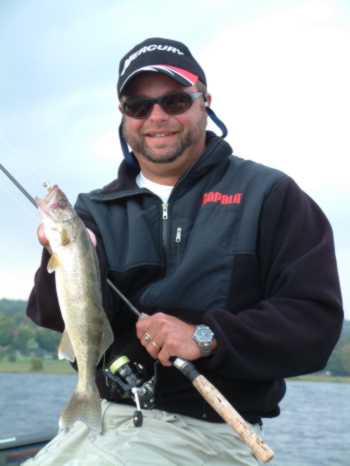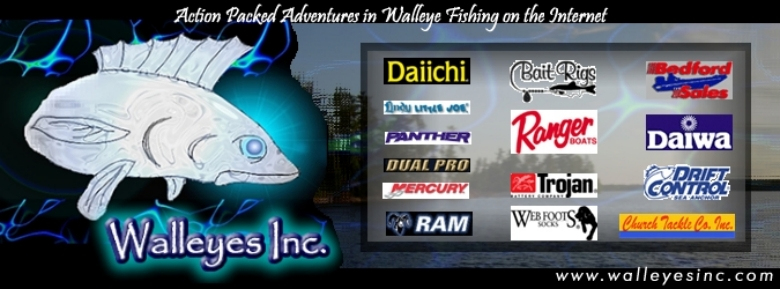Are bugs the first thing that comes to mind when you think
about fishing during the early months of summer? They should
be. And I’m not just talking about the pesky little
fly-in-your-face bugs that swarm over you at the boat launch—although
they do play a huge roll with the walleye bite this time of
year. I’m talking bugs of all kinds, including aquatic
insects. Key in on bug hatches and you’ll find feeding
game fish.
Lakes and rivers come alive as late spring turns to summer.
Bugs hatch, small fishes, minnows, and crustaceans feed on
the molting insects, and then predator fish feed on them all.
Walleye, one of the main predators, are done spawning and
are now focused solely on filling their bellies with the smorgasbord
before them.
Seek, and yee shall find
Finding just where it is the bugs are hatching is not hard.
I watch the water’s surface with nothing more than my
eyes, or use my Lowrance sonar and Aqua-Vu to find submerged
insects.
Ever sit on shore, hot coffee in hand, and take in the lake
as the morning mist rises off the flat-calm surface? You almost
always see little dimples—looking like rain drops hitting
the surface—forming from seemingly nowhere in certain
areas of the lake in the early morning light. Those are bugs—nymphs
that wiggled their way from the bottom and are now hatching
on the surface. I guarantee you there are more than just those
insects in those areas—there’s the aforementioned
small fish, minnows, as well as predator fish. Better grab
your rod and reel—the bite’s on.
 |
When the water’s calm, I look for
these little rings on the surface over deep water, and
then set a course for them. But I don’t run my
boat right through the mass of hatching bugs as that
would not only spook any game fish, but would also riel
the environment enough to stop the hatch all together
in that spot.
When I’m trolling, I quietly motor my Lund with
either the Mercury 9.9-hp 4-stroke kicker or with the
bow-mounted MotorGuide electric towards, but off to
the side of where the hatch is taking place, and pull
my spinner harnesses or crankbaits through the hatch
area with Church Tackle in-line planer boards. To keep
as stealthy as possible, I like to use Church’s
smaller TX-12 or TX-6 boards rather than the larger
boards. These little boards won’t churn the calm
surface and put down the bite or emergers.
|
I also like to cast to bug hatches when I see them occurring
in the shallows. I use only the MotorGuide electric to position
my boat. I make sure to stay well enough away from the hatching
insects, yet within casting distance.
How do I find insects when they are not in the process of
hatching? With my Lowrance sonar, of course; and when I add
a Navionics mapping chip to the unit, I not only know where
the submerged bugs are at the moment (with the Lowrance),
but am also able to decipher where the bugs may be in other
areas of the lake.
What do bugs look like on my Lowrance? Any number of things,
really. That surface clutter the Lowrance is marking high
in the water column is dust and plankton. There are insects
in there too. Or I may see a strange mass on the screen. That,
too, is probably bugs. Sometimes individual nymphs look like
thin streaks going diagonally on the screen. They look like
this as they are wiggling their way up off bottom, and the
signal shows as a line as the screen scrolls.
I know that if I get my lure down into the same zone the
masses are, I’ll also be getting it into the fish zone.
I may not be marking fish on the Lowrance (only because they
tend to scoot out of transducer range when high in the water
column) but they are there. Again, walleye follow food this
time of year, and insects are not just a food source, but
the food source.
Certain insects tend to be in particular areas of a lake—over
soft bottom, for example, or within the thermocline over specific
water depths. When I mark a mass of bugs on my Lowrance sonar
I not only pay attention to what depth they are at in the
water column but how deep the water is and the type of bottom
(hard, soft, flat or drop off). More than likely, other places
on the lake with comparable characteristics will have similar
bug masses.
With the information from a Navionics mapping cartridge telling
me exactly the lay of the underwater land, I can check out
other places of the lake where bugs, thus walleye may be found.
On the Great Lakes , Navionics new Platinum chip will show
me in 3-D how the lay of the bottom. This really helps me
key in on similar structure, especially in such a large body
of water. As time wares on, there will be more inland lakes
on the Navionics Platinum chip, I’m sure.
In shallower water (15 feet or less) I use my Aqua-Vu underwater
viewing system to spot insects. I stick to structure when
using the Aqua-Vu, such as weeds and wood, and watch for insects
scouring about. This is when I break out the jigging rod.
Match Maker
Walleye tend to get very size specific in their feeding when
insects are hatching, zoning in on the tiny insects themselves
as well as the small fishes and minnows that are feed on them.
During a bug hatch, I use small spinners, crankbaits, and
jigs to best match the hatch.
When using spinners, I reduce the size of my Northland blades
to number 1, 2 or 3’s, and then only use a small portion
of a live night crawler or small piece of Berkley Gulp! or
PowerBait Night Crawler, rather than a whole one. Blades with
a gold or copper hue to them are always a good choice as they
best match the natural color of many insects.
When trolling crankbaits, I like to use size-5 and -7 Rapala
Shad Raps and the same size Tail Dancers. If I’m casting,
I’ll throw size-3 and -5 Rapala CountDowns, size-5 and
-7 Original Floaters, and Jointed, as well as size-6 and -8
Rapala Husky Jerks and size-8 and -10 X-Raps. As for lure
color, I like to match the color of the forage when fishing
in clear water, and go with florescent colors when fishing
stained water.
When tossing jigs in shallow water, I reduce the size of
the jighead down 1/16- to 1/8-ounce Northland Buck-Shot Rattle
Jig and a 2-inch Berkley Ribbontail Power Grub. The color
spectrum of jig and plastic combos is endless—I like
to take several different ones with me and try them all until
I find the one color that works best.
In the end
Do insects drive you buggy during late spring/early summer?
I hope so. Ignore them and you’ll be missing out on
some of the best fishing of the year. Find them with your
eyes as they hatch off the surface, or with electronics when
their submersed, and reduce the size of your lures and bait,
and you’ll catch walleye, for sure.
Mark Martin is a walleye tournament pro and fishing school
instructor who lives in Michigan ’s southeastern Lower
Peninsula . Check out www.markmartins.net
for more information on up-coming schools.
|

